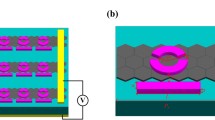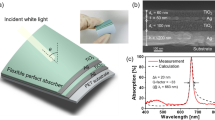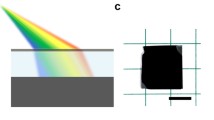Abstract
Metallic rugate filters are theoretically investigated for the first time. Our model builds on randomly dispersed metallic nanorod arrays with sinusoidally varying porosities along the film thickness. It was found that metallic rugate filters can display strong optical response in the visible and near-infrared regions for both TE and TM polarizations and for a wide range of incident angles. Moreover, the optical features of a metallic rugate filter can be fine tuned by adjusting its structural features. Interestingly, multiple-peak rugate filters can be conveniently achieved by combining different periodicities in one rugate structure. The interesting optical behaviors of the novel metal-based reflectors, combined with the many desirable properties of metals (e.g. electric, thermal, magnetic, mechanical, and chemical properties) are bound to lead to various multi-functional optical devices.
Similar content being viewed by others
Explore related subjects
Discover the latest articles, news and stories from top researchers in related subjects.Avoid common mistakes on your manuscript.
1 Introduction
Rugate filters [1], being a type of optical reflector whose refractive index varies continuously (mostly sinusoidally) along the film thickness direction, have been investigated for many decades both theoretically and experimentally. The optical responses of rugate filters are highly dependent on their structural features and their building materials. Compared to Bragg stacks [2], which is another type of commonly used optical reflectors whose refractive index follows a square-wave profile along the film thickness direction, the smooth variation of refractive index of rugate filters is particularly useful for reducing device internal stress and suppressing the undesired higher harmonics and side lobes of the reflection peaks [3].
To date, research work on rugate filters has been focused on dielectric materials. For example, dielectric rugate filters have been reportedly fabricated by physical vapor deposition, plasma-enhanced chemical vapor deposition, glancing angle deposition, and electrochemical etching [4]. On the contrary, there are very few reports on the fabrication of metallic rugate filters [5]. Moreover, although theoretical modeling of dielectric rugate filters has been well investigated, to our knowledge no theoretical study of metallic rugate filters has been reported. The lack of attention paid to metal-based rugate filters is possibly due to the fact that metals are generally more difficult to be processed into nanostructures than dielectrics and to realize smoothly varying structural features (e.g. the porosity) in metals is particularly challenging. Nevertheless, it should be pointed out that rugate filters constructed from metals are to benefit from the many unique properties of metals, e.g. high electrical conductivity, high thermal conductivity, magnetic responses, superior mechanical performance, and rich surface chemistry, potentially leading to interesting multi-functional rugate filters. Another reason behind the lack of attention to metallic rugate filters is possibly due to the fact that metals are generally considered as high-absorption materials and rugate filters are generally used as reflectors. Therefore, it appears counter-intuitive to construct rugate filters from metallic materials.
On the other hand, in recent years, photonic devices based on metallic nanostructures have attracted tremendous attention both theoretically and experimentally for their exciting optical properties and various potential applications, such as optoelectronic devices [6, 7], superlenses [8, 9], biosensing materials [10, 11], and surface enhanced Raman scattering (SERS) substrates. Along with the progress in the fast-growing field of metallic photonic materials, the techniques for fabricating elaborate metallic nanostructures have been greatly improved and enriched. For example, lately our group reported a convenient solution-based electrochemical method for generating nanoporous metallic multi-layers whose porosity can be continuously modulated along the film thickness direction. The flexibility and the accuracy of this method were embodied in the realization of the first metallic counterparts of dielectric rugate filters with the structural periodicity in the sub-wavelength range.
Considering the encouraging progresses in the fabrication techniques of the metallic nanostructures, it is meaningful and useful to systematically investigate the metal-based rugate filters. Here, we report a systematic theoretical study of metal-based rugate filters using the scattering matrix method (SMM) and the finite-difference time-domain (FDTD) method. Nanorod-based metallic multi-layered films whose porosity sinusoidally varies along the film thickness direction were used as the structural model to study metallic rugate filters. It is found that metallic rugate filters can show strong reflectivity in the visible and near-infrared (near-IR) regions for both TE and TM polarizations and for a wide range of incident angles. Moreover, their optical responses can be tailored by adjusting different structural parameters.
2 Methods of calculation and structural model
Two methods were used to calculate the reflection and transmission spectra of metallic rugate filters with normal incidence. The first method combines the Maxwell–Garnett (MG) effective medium theory [12] and the SMM, and the second is the FDTD method. We used the Lorentz–Drude (LD) model to describe metals in both methods because the LD model gives good fit of the exact permittivity value of metals [13, 14]. The LD model is expressed in the following form:
where ω p is the plasma frequency and k is the number of oscillators with resonant frequency ω j , strength f j , and lifetime 1/γ.
For the first method, one period of the rugate filter structures was divided into m sub-layers with equal thickness; the porosity of the ith sub-layer, p i , was described as

where z i =id/m,p a is the average porosity, A is the amplitude of the porosity, and d is the thickness of one period of the rugate filter. Assuming that the feature size is much smaller than the wavelength concerned, each sub-layer was treated as a homogeneous material with effective permittivity ε eff by MG effective medium theory:
Meanwhile, we applied the FDTD method to simulate the rugate filters using the commercial software EastFDTD. A periodic boundary condition was applied in the x axis and the y axis. A perfectly matched layer boundary condition was applied in the z axis, which is the electromagnetic wave propagation direction.
Porous films consisting of randomly spaced metal nanorods which stand vertically on a dielectric substrate were used to model the metallic rugate filter structures (Fig. 1). The porosity of the film varies sinusoidally along the film thickness direction with the starting phase set as π at the film top surface. The periodicity, the amplitude of the porosity, the average porosity, and the period number were denoted as d,A,p a, and n, respectively. To simplify the calculation, the refractive index of the underlying dielectric substrate was set to one.
3 Results and discussion
The normal incident TE polarization reflection and transmission spectra of metal rugate filters were calculated with d=200 nm, A=0.1,p a=0.8, and n=8 (Fig. 2). Five metals were studied: Ag, Au, Cu, Al, and Ni. One reflection peak due to the rugate structure was observed in the case of Au, Cu, Al, and Ni. Notably, in the case of Ag, two reflection peaks appeared with the first one positioned at 370 nm ascribed to the bulk plasmon resonance of Ag [15] and the second one at 576 nm the rugate structure. Among all the metals studied, Ag and Al have the highest rugate reflection peaks (∼0.8), while Ni has the lowest (∼0.3). With the above-described structural parameters, the rugate reflection peaks for the five types of metals are all located in the visible region. As expected, transmission dips appear at the same positions of the corresponding reflection peaks in the simulated transmission spectra. Notably, high transmission from 900 to 2000 nm is present for all the studied metal rugate filters. This interesting near-IR transparency [16, 17] does not originate from the rugate structure but is attributed to the high porosity of the metal nanorod arrays, as revealed by the control study on nanorod arrays with homogenous porosity.
We further studied the impact of different structural parameters on the optical responses of the metallic rugate filters by using Al-based rugate filters as the exemplary system. The following structural parameters were investigated. (1) Periodicity, d. The rugate reflection peak red shifts gradually from 410 to 670 nm when d is increased from 150 to 250 nm (Fig. 3). (2) Average porosity, p a. When the average porosity p a is increased from 0.4 to 0.8, the reflection peak blue shifts from 1010 to 540 nm with its full width at half maximum (FWHM) significantly reduced (Fig. 4). Meanwhile, the baseline of the reflection spectrum drops, indicating that the surface impedance of the structure is changed. (3) Amplitude of porosity, A. When A is reduced from 0.15 to 0.05, the rugate reflection peak becomes significantly narrower and lower (Fig. 5). This finding is consistent with the extreme case: when A approaches zero, the periodicity in the z axis will disappear, and so will the rugate reflection peak. From the above simulation, it is evident that the optical features of metal-based rugate filters can be fine tuned through adjusting different structural parameters.
Moreover, using Al-based rugate filters as the exemplary system, angle dependency of both TE and TM polarizations was investigated for the metallic rugate filters (Fig. 6). For both TE and TM polarizations, with the incident angle increased from 0° to 60°, the rugate reflection peak gradually blue shifts. However, the intensity and FWHM of the rugate reflection peak only slightly increase for TE polarization with the incident angle increased from 0° to 60°, whereas, for TM polarization, the intensity and FWHM of the rugate reflection peak dramatically decrease with the incident angle at 60°, which is possibly due to the reduced incident electric field for TM polarization at higher angles.
To validate the simulation results obtained using the SMM, the FDTD method was applied to simulate metallic rugate filters that comprise vertically standing nanorods arranged in a periodic square array in the x–y plane (Fig. 7). Along the z axis, the porosity of the nanorod array varies sinusoidally with d=200 nm, A=0.1,p a=0.8, and n=8. Different lengths of the square-shaped repeating unit (i.e. 30 nm, 150 nm, and 300 nm) in the x–y plane were studied. When the periodicity in the x–y plane is 30 nm, the result simulated by the FDTD method matched well with the SMM. However, with the periodicity in the x–y plane increases to for instance 150 or 300 nm, reflection peaks with significantly blue-shifted location and increased FWHM were obtained with the FDTD method. This observed discrepancy between the two calculation methods at large length scale is ascribed to the fact that the effective medium theory is valid only when the structural dimension is much smaller, usually one order of magnitude smaller, than the wavelength of the incident light. It is noteworthy that when the periodicity in the x–y plane is 300 nm, a new peak emerges at around 310 nm. This peak can possibly be attributed to the localized surface plasmon resonance effect of the two-dimensional periodic metal array [18].
Normal incident TE polarization reflection spectra of Al-based rugate filters (d=200 nm, A=0.1,p a=0.8, and n=8) calculated using the SMM (‘SMM’) and the FDTD method (‘30 nm’, ‘150 nm’, and ‘300 nm’). For the FDTD method, the periodicity of the square array in the x–y plane was set to be 30 nm, 150 nm, and 300 nm
Moreover, interestingly, similar to dielectric rugate filters [19], multiple rugate reflection peaks can be achieved on metallic rugate filters by integrating several rugate filter components into one structure, i.e. by building a structure with multiple periodicities along the z axis. For example, a ‘dual’ rugate structure can be obtained with the porosity p varying along the z axis following Eq. (4):

Using this strategy, a ‘dual’ rugate structure is designed with d 1=200 nm, d 2=220 nm, A=0.1, and p a=0.8, and the total film thickness of 22000 nm. FDTD simulation results of this structure clearly show dual characteristic rugate peaks that originate from the two rugate filter components (Fig. 8).
Normal incident TE polarization reflection spectra of an Al-based ‘dual’ rugate structure (‘dual’) (filmthickness=22000 nm) and the two corresponding rugate filter components (d 1=200 nm, d 2=220 nm, A=0.1,p a=0.8,n=10), calculated using the FDTD method with the periodicity of the square lattice in the x–y plane set to be 30 nm
4 Conclusions
In this study, metallic rugate filters have been theoretically studied for the first time. Our model is based on a nanoporous metal film with the film porosity varying sinusoidally along the film thickness direction. The impacts of different metal species (e.g. Ag, Au, Cu, Al, and Ni), structural parameters (e.g. periodicity, average porosity, and amplitude of porosity), TE and TM polarizations, and incident angles have been systematically investigated using the SMM and FDTD method. It was found that metallic (e.g. Al) rugate filters are able to display strong optical response in the visible and near-IR regions for both TE and TM polarizations and a wide range of incident angles. The optical response of the metallic rugate filters can be fine tuned by adjusting the various structural parameters. Furthermore, multiple rugate peaks are achievable from a single metallic rugate structure. Considering the superior electrical conductivity, thermal conductivity, magnetic responses, and mechanical performance of metals, metallic rugate filters are believed to open new routes to a wide range of multi-functional optical devices.
References
B.G. Bovard, Appl. Opt. 32, 5427 (1993)
L. Zhai, A.J. Nolte, R.E. Cohen, M.F. Rubner, Macromolecules 37, 6113 (2004)
M.G. Berger, R. Arens-Fischer, M. Thonissen, M. Kruger, S. Billat, H. Luth, S. Hilbrich, W. Theiss, P. Grosse, Thin Solid Films 297, 237 (1997)
E. Lorenzo, C.J. Oton, N.E. Capuj, M. Ghulinyan, D. Navarro-Urrios, Z. Gaburro, L. Pavesi, Appl. Opt. 44, 5415 (2005)
C.K. Tsang, Z.T. Xu, Y.Y. Li, J. Electrochem. Soc. 156, D508 (2009)
M.M. Alkaisi, R.J. Blaikie, S.J. McNab, R. Cheung, D.R.S. Cumming, Appl. Phys. Lett. 75, 3560 (1999)
X.G. Luo, T. Ishihara, Jpn. J. Appl. Phys. 43, 4017 (2004)
S. Kawata, Y. Inouye, P. Verma, Nat. Photonics 3, 388 (2009)
N. Fang, H. Lee, C. Sun, X. Zhang, Science 308, 534 (2005)
J.N. Anker, W.P. Hall, O. Lyandres, N.C. Shah, J. Zhao, R.P. Van Duyne, Nat. Mater. 7, 442 (2008)
J. Homola, Chem. Rev. 108, 462 (2008)
T.C. Choy, Effective Medium Theory: Principles and Applications (Oxford University Press, New York, 1999)
M.A. Ordal, L.L. Long, R.J. Bell, S.E. Bell, R.R. Bell Jr., R.W. Alexander, C.A. Ward, Appl. Opt. 22, 1099 (1983)
P.B. Johnson, R.W. Christy, Phys. Rev. B 6, 4370 (1972)
S.A. Maier, Plasmonics: Fundamentals and Applications (Springer, London, 2007)
K.S. Kim, Y. Zhao, H. Jang, S.Y. Lee, J.M. Kim, K.S. Kim, J.H. Ahn, P. Kim, J.Y. Choi, B.H. Hong, Nature 457, 706 (2009)
J.Y. Lee, S.T. Connor, Y. Cui, P. Peumans, Nano Lett. 8, 689 (2008)
X.C. Lu, J.G. Han, W.L. Zhang, Appl. Phys. Lett. 92, 121103 (2008)
S.O. Meade, M.S. Yoon, K.H. Ahn, M.J. Sailor, Adv. Mater. 16, 1811 (2004)
Acknowledgements
This work is supported by City University of Hong Kong (Projects 7008080 and 9667056).
Author information
Authors and Affiliations
Corresponding author
Rights and permissions
About this article
Cite this article
Shu, S.W., Zhang, J., Tsang, C.K. et al. Metal-based rugate filters with strong visible and near-infrared reflectivity. Appl. Phys. B 107, 669–673 (2012). https://doi.org/10.1007/s00340-012-5064-z
Received:
Published:
Issue Date:
DOI: https://doi.org/10.1007/s00340-012-5064-z












